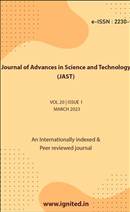The Impact of Big Data on Statistical Analysis Methods
DOI:
https://doi.org/10.29070/8kk42z91Keywords:
big data, statistical analysis methods, cutting-edge methods, challenges, enormous information, datasets, distributed technologies, Hadoop, Spark, scalability, parallel processing capability, secondary analysis, revolutionized, data analysisAbstract
Big data's revolutionary effects on statistical analysis are the subject of this dissertation, whichalso examines the cutting-edge methods and strategies required to realize its full potential and overcomeits inherent challenges. The materials and approach engaged with involving enormous information forthe factual examination have been talked about in this part. As far as materials, large information alludesto immense, confounded datasets that are regularly excessively tremendous for customary informationhandling methods to deal with. When dealing with massive amounts of data, distributed technologiesand systems like Hadoop and Spark are frequently utilized. The scalability and parallel processingcapability of big data technology are crucial to statistical analysis. The impact of big data on statisticalanalysis techniques is the subject of secondary analysis. The inclusion of big data in statistical analysismethods has revolutionized the field of data analysis.Downloads
References
Dubey, R., Gunasekaran, A., Childe, S.J., Blome, C. and Papadopoulos, T., 2019. Big data and predictive analytics and manufacturing performance: integrating institutional theory, resource‐based view and big data culture. British Journal of Management, 30(2), pp.341-361.
Bag, S., Wood, L.C., Xu, L., Dhamija, P. and Kayikci, Y., 2020. Big data analytics as an operational excellence approach to enhance sustainable supply chain performance. Resources, Conservation and Recycling, 153, p.104559.
Luo, J., Wang, Z., Xu, L., Wang, A.C., Han, K., Jiang, T., Lai, Q., Bai, Y., Tang, W., Fan, F.R. and Wang, Z.L., 2019. Flexible and durable wood-based triboelectric nanogenerators for self-powered sensing in athletic big data analytics. Nature communications, 10(1), p.5147.
Hariri, R.H., Fredericks, E.M. and Bowers, K.M., 2019. Uncertainty in big data analytics: survey, opportunities, and challenges. Journal of Big Data, 6(1), pp.1-16.
Raut, R.D., Mangla, S.K., Narwane, V.S., Gardas, B.B., Priyadarshinee, P. and Narkhede, B.E., 2019. Linking big data analytics and operational sustainability practices for sustainable business management. Journal of cleaner production, 224, pp.10-24.
Hariri, R.H., Fredericks, E.M. and Bowers, K.M., 2019. Uncertainty in big data analytics: survey, opportunities, and challenges. Journal of Big Data, 6(1), pp.1-16.
Wamba, S.F., Dubey, R., Gunasekaran, A. and Akter, S., 2020. The performance effects of big data analytics and supply chain ambidexterity: The moderating effect of environmental dynamism. International Journal of Production Economics, 222, p.107498.
Mikalef, P., Krogstie, J., Pappas, I.O. and Pavlou, P., 2020. Exploring the relationship between big data analytics capability and competitive performance: The mediating roles of dynamic and operational capabilities. Information & Management, 57(2), p.103169.
Mikalef, P., Boura, M., Lekakos, G. and Krogstie, J., 2019. Big data analytics capabilities and innovation: the mediating role of dynamic capabilities and moderating effect of the environment. British Journal of Management, 30(2), pp.272-298.






